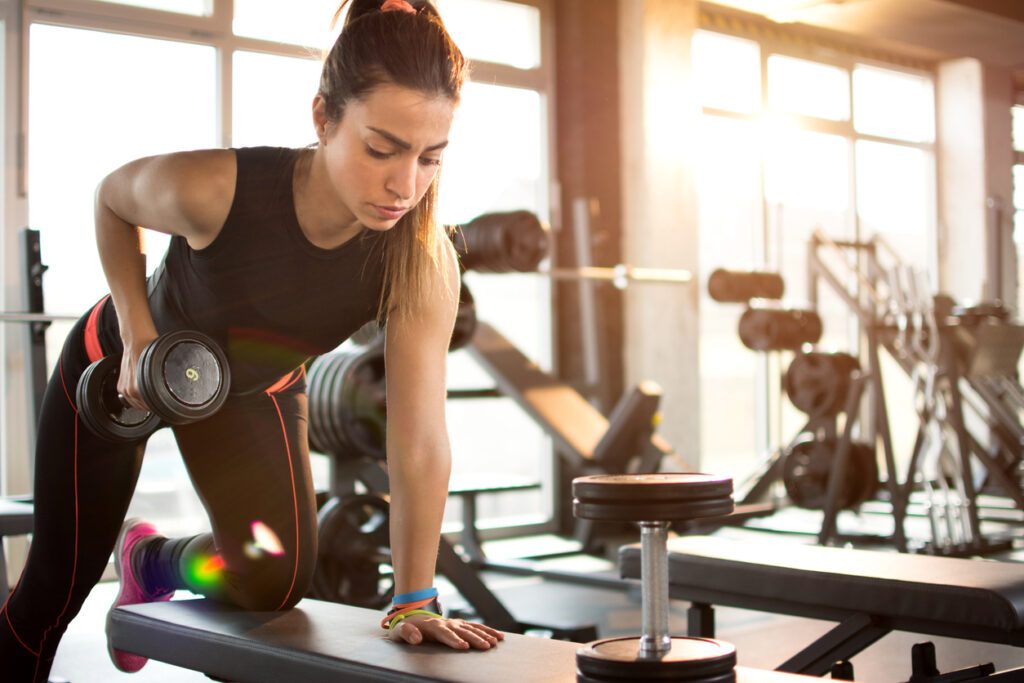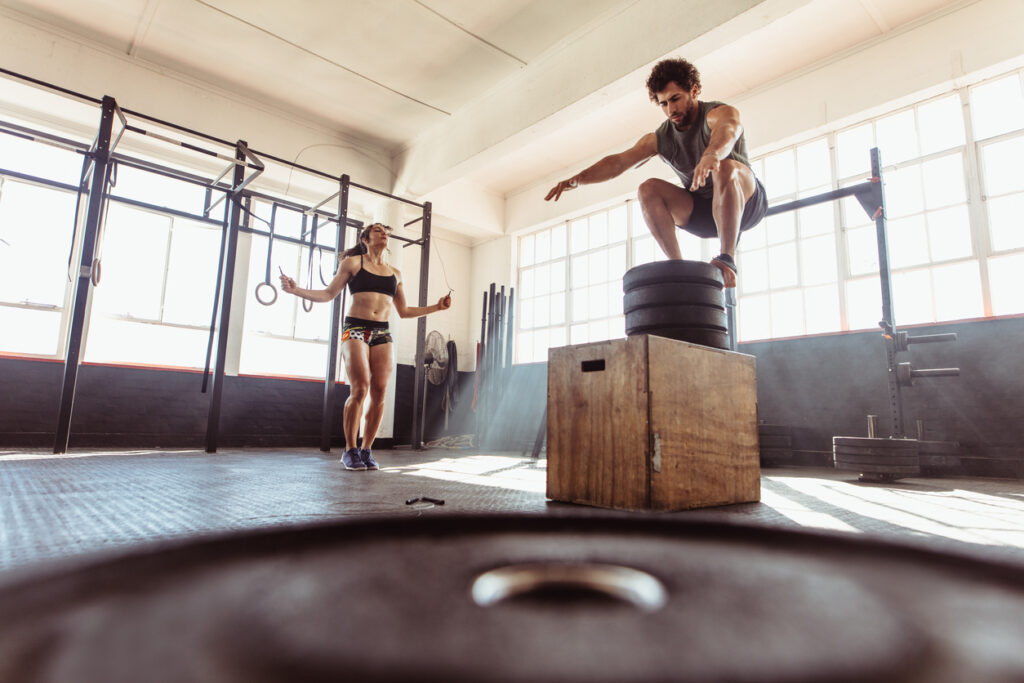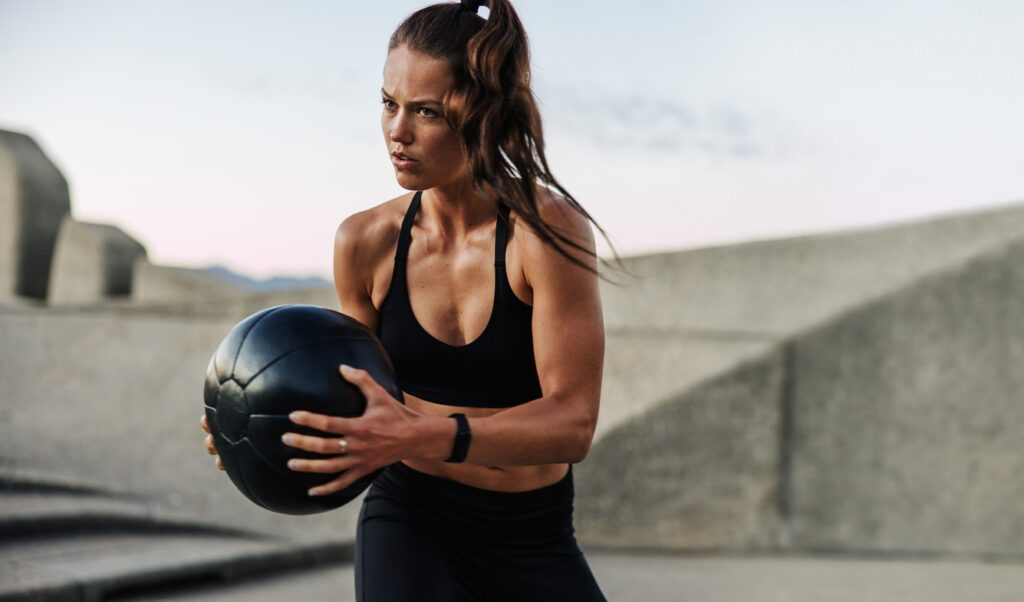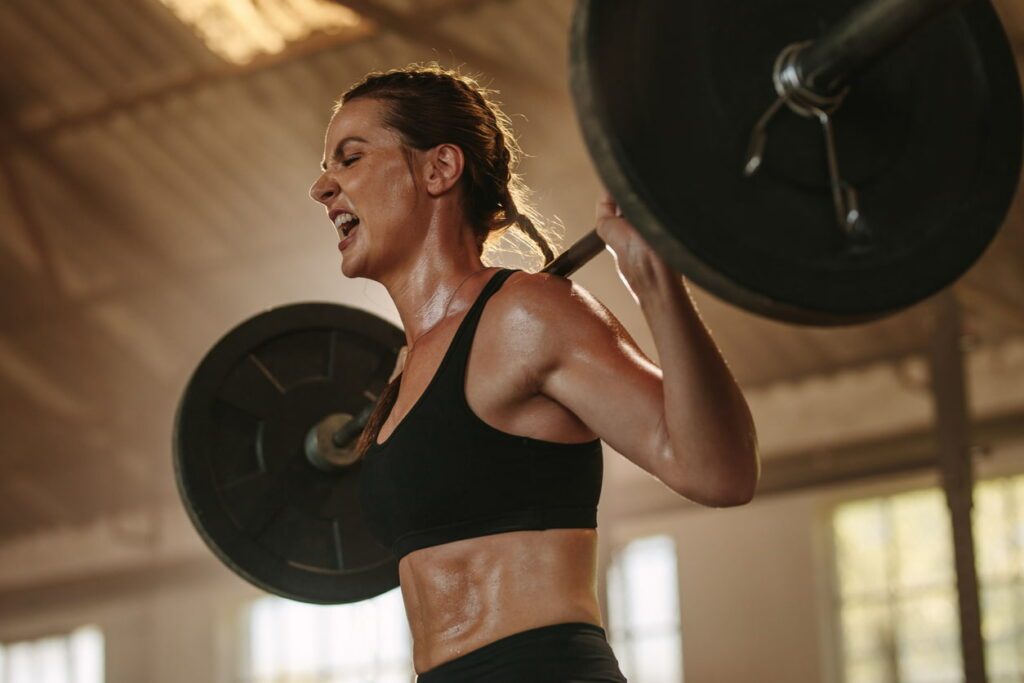
Summary
Welcome / Welcome / Tips for getting started / HIIT weight loss program: burn as many calories as possible!
HIIT weight loss program: burn as many calories as possible!
You look for an effective way to lose weight? HIIT could be your answer. This programme intensive training, generally between 20 and 30 minutes. minutesIt burns calories at lightning speed, delivering rapid results.
HIIT, or high-intensity interval training, is a type of training that method of sport which mixes periods of effort cardio intense with moments of rest. If chosen correctly, HIIT exercises maximise the burning of fat. fats while strengthening your muscles, developing your immune system. muscular mass and improving your physics.
But what is the best HIIT exercise for achieving your goals? goals to lose weight? And how do you structure your programs for optimum results? If these questions are on your lips, this article is for you. Ready to sweat? Let's go! 🔥
Summary
What is HIIT?
Before we begin, we're going to give you a detailed introduction to HIIT, the method effective. If you're a seasoned practitioner, you'll need a few tips to get you started. advice a little refreshment won't do you any harm!
THE HIIT, from English High Intensity Interval Training, is a method training programme based on alternating between phases of cardio exercise performed at maximum intensity and rest or active recovery phases.
This training sports offers convincing results in a short space of time. Whether you're looking to lose weight, improve your endurance or strengthen your muscular mass and your physicsHIIT could be the key to achieving your goals. goals.
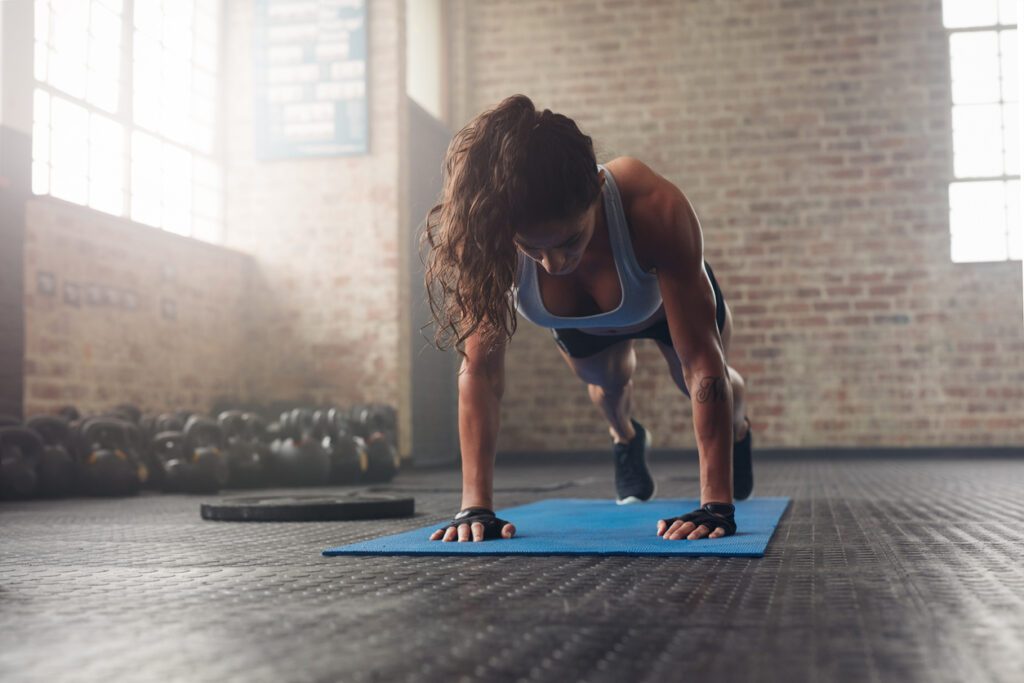
The benefits of HIIT
Burn calories
The main characteristic of HIIT is the combination of short but very intense exercises, followed by periods of rest or lighter efforts. These peaks in intensity, thanks in particular to the cardioThe heart rate increases dramatically, forcing the body to expend a great deal of energy in very few minutesin particular by burning fats. The more intense the effort, the greater the calorie expenditure and fat loss. This programme HIIT adapts to your goals and is part of a power supply to optimise weight loss.
The after-burning effect
One of the major advantages of HIIT lies in the phenomenon known as theafterburner effect, more precisely called “Excess Post-exercise Oxygen Consumption"(Excessive Oxygen Consumption after Exercise). After a HIIT session, the body continues to consume oxygen at a higher rate than normal, leading to an increase in calorie expenditure during the workout. several hours after the end of the exercise. This means that not only do you burn calories during your session, but also after it, even while resting!
Metabolism stimulation
The intense nature of HIIT causes acceleration of metabolism. This increase in the rate at which the body converts calories into energy results in better ability to burn fatEven when you're not exercising.
Muscle strengthening
HIIT sessions generally consist of a variety of exercises that target different muscle groups, including the legs. Whether it's squats, burpees, push-ups or jumps, each movement puts an intense demand on the muscles, pushing them to work hard for short intervals. This varied workout helps to ensure a complete muscle strengthening.
Intensity is also beneficial for building muscle. By exercising at maximum intensity, even for short periods, you will push your muscles to their limits. This overload is essential for stimulate muscle growth and strengtheningcontributing to a better mass body.
Development of respiratory and cardiovascular endurance
During the intense effort phases of HIIT, your heart and lungs have to work at full capacity to supply your muscles with the oxygen they need. This maximum effort, even if it's only for a short time, leads to a adaptation of the cardio-respiratory systemmaking it more effective over time and improving your productivity. physics.
Alternating between periods of intense effort and periods of active recovery mimics the variations in oxygenation encountered in many sports and activities. This makes it possible to develop the body's ability to effectively manage rapid changes in oxygen demandThis helps boost respiratory endurance.
With the intensity of HIIT sessions, the heart strengthens and becomes more efficient. Over time, this can lead to an increase in the systolic ejection volume (the amount of blood ejected by the heart with each beat), which improves cardiovascular efficiency and endurancesupporting your goals physical.
Quick workout
The main feature of HIIT is its interval-based structure: short periods of intense effort followed by short periods of rest or moderate effort. A typical HIIT session can last between 15 and 30 minuteswhich is considerably less than the duration of a traditional training session. Despite this brevity, thanks to the intensity of the effort, the benefits are comparable to, or even greater than, those of longer training sessions.
With such short sessions, it's much easier to fit HIIT into a busy schedule. Whether it's during your lunch break, early in the morning or even at the end of the day, it's always possible to find a time slot for a quick session, thereby optimising your time. programme sporty.
No hardware needed
A lot of HIIT routines are based on bodyweight exercises, which means that you don't have to do any weight training. not necessarily need access to a gym or specialist equipment. You can therefore start a HIIT session whenever you have a bit of free time, whether at home, in a park or even in a hotel room, using, for example, a bike stationary to vary your cardio exercises.
A fun workout
Unlike some forms of training, which may focus on repetitive movements, HIIT is based on a multitude of exercises. Each session can be different from the previous one, allowing you to work out in a different way. avoid monotony and of always keep training fresh and excitingsupporting your motivation and your goals.
The very nature of the intervals - alternating phases of intense effort with moments of rest or more moderate effort - creates a dynamic rhythm. This rapid pace can give the impression that time is passing more quickly and that you're in a hurry. maintains attention and commitment throughout the sessionmaking the most of every minute of your programme.
Although HIIT can be done alone, it is also popular in group classes. Training with others, sharing the intensity of the intervals and encouraging each other adds a new dimension to HIIT. a social and fun aspect to routine, making the sport even more enjoyable.
Improved aerobic and anaerobic capacities
There aerobic capacity refers to the body's ability to produce energy using oxygen, usually duringprolonged efforts. There anaerobic capacityon the other hand, concerns the production of energy without oxygen, often duringshort, intense efforts. HIIT stands out because it allows you to work on and improve both of these skills simultaneously, optimising your fitness. physics and your sports performance.
The very structure of HIIT mimics the functioning of the body's aerobic and anaerobic energy systems. Short, intense sprints require the anaerobic metabolismwhile periods of active recovery and intervals of more moderate effort stress the aerobic systemoffering a complete and balanced workout.
The maximum effort phases of HIIT place intense demands on the anaerobic system. Over time, this improves the ability of muscles to function in conditions where oxygen supply is limitedlike during a sprint or an explosive effort, thus reinforcing your legs and your overall endurance.
Injury prevention
Unlike long training sessions, which can put joints, tendons and muscles under prolonged strain, HIIT sessions are shorter, thereby reducing the risk of injury and enabling faster recovery thanks to advice suitable.
HIIT incorporates a wide range of exercises that target different muscle groups. This variety prevents over-stimulation of a specific muscle group, which reduces the risk of overexertion and associated injurieswhile promoting the harmonious development of the muscular mass.
By regularly using the muscles at high intensity, HIIT promotes general muscle strengthening. Strong, well-trained muscles provide a better joint supportThis can help minimise the risk of injury and improve your performance. physics overall.
HIIT weight loss program: how to structure it
Working and rest time
The composition of your HIIT circuit depends on your level of fitness and your goals.
- If you are starting, take a rest time equivalent to or slightly less than your work time (for example, 30 seconds of exercise and 30 seconds of rest).
- If you are rather intermediate, increase your effort interval and decrease the recovery interval (30 seconds of effort, 15 seconds of rest).
- If you are hardened, challenge yourself and further reduce the effort/rest gap (for example, 45 seconds of exercise and 15 seconds to recover).
Warming up
Before you start your workout, don't forget to warm up well to prepare your muscles, your joints And your tendonsbut also for limit the risk of muscle and joint injuries. A good power supply and advice can also optimise your warm-up.
Your warm-up should be done in three stages:
- A cardiovascular warm-up to raise your body temperature and heart rate;
- A joint heating to prepare the joints you will use during your session;
- A specific warm-up, that is to say, make dynamic gestures that are similar to the exercises that you will perform in your circuit.
Stretching
For preserve the health of your muscles, it is important to stretch before and after your session.
Before your session, it's important to do some dynamic stretching to prepare your body for exercise. These stretches increase muscle temperature, improve joint amplitude, And optimize coordinationsupporting your programme training.
At the end of your session, don't forget to do a few static stretches. These allow relax the muscles you have used, promote better blood circulation And limit the risk of achesmaking it easier for you to recover.
The best forms of HIIT for weight loss
HIIT jump rope
The benefits of jumping rope
The skipping rope is an accessory that offers many advantages:
- She allows to burn lots of calories quickly thanks to cardio intense ;
- She tones the musclesincluding legs;
- She works on enduranceessential for any programme sports ;
- She strengthens the heart;
- She works coordination, balance and agility;
- She improves concentration;
- She is easily transportable;
- She can be practiced anywhereWhether at home, in the park or at the gym.
Clearly, skipping rope is a highly beneficial exercise, particularly for HIIT. It's perfect for interval training. Combine phases of skipping rope with exercises in cardio (jumping jacks, burpees...) or bodybuilding to establish a complete and effective HIIT circuitin line with your goals weight loss.
Example of a HIIT jump rope circuit
This circuit combines skipping rope and bodybuilding to strengthen the whole body. For this circuit, you need to do 40 seconds of exercise and take 20 seconds of rest between each exercise. Repeat the circuit three timesby concentrating on the quality of each movement to maximise the efficiency of your movements. loss of body fat.
- Jumping rope - classic jumps
- Squats
- Jumping rope - hopping jumps
- Pumps
- Jumping rope - maximum speed
If you want to discover more programs and learn more about the benefits of skipping ropewe wrote an article about it. 👀
HIIT running
Running is a good way to lose weight in the long term. Combining running with HIIT gives you an opportunity to make your workout routine more fun And get better results without having to travel long distances, thus maximising the loss of body fat.
Example of a HIIT running circuit
This circuit is designed to improve endurance and speed. You will alternate between sprint phases and walking phases to recover. The circuit works as follows:
- 30 second sprint ;
- 1 minute of walking at a brisk pace.
Perform 8 rounds of this circuit. Your workout will last 12 minutesoptimising your programme HIIT for maximum efficiency.
The best HIIT exercises
HIIT upper body exercises
The pumps
Push-ups are one of the most versatile and effective exercises for strengthening the upper body and trunk, contributing to a healthier and more active body. muscular mass and a physics harmonious.
- Start in a plank position with your hands placed slightly wider than shoulder-width apart. Your feet can be placed together or apart depending on what is most comfortable for you. Your body should form a straight line from head to heels.
- Keeping your body rigid and straight, bend your elbows to lower your body towards the ground. Your elbows should form a 45° angle with your torso, preventing them from spreading too far apart.
- Once your chest is almost level with the floor (or as soon as your range allows), push firmly against the floor, extending your arms to return to the starting position.
Dips
Dips are an effective way of working several upper-body muscle groups in a single movement, thus helping to improve the body's overall condition. muscular mass and a physics toned.
- Start by finding a pair of parallel bars for dips or, if you're at home, use the edge of a stable bench or chair. Place your hands on the bar or bench, fingers facing forward. Extend your arms and lift your body, keeping your elbows slightly bent to avoid strain.
- Keeping your torso tilted slightly forward, bend your elbows to lower your body. Your elbows should stay close to your body and form a 90-degree angle in the lowest position.
- Use the strength in your triceps to push up and return to the starting position, extending your arms but not locking them at the end of the movement.
Rowing
The rowing exercise involves the large dorsal muscles, trapezius, rhomboids and arm muscles such as the biceps. Incorporating this exercise into your HIIT sessions provides deep muscle strengthening while improving endurance and strength. muscular mass.
- Stand with your feet shoulder-width apart. Hold a dumbbell in each hand with a neutral grip (palms facing your body).
- Bend your knees slightly and lean forward from the hips. Keep your back straight and your torso almost parallel to the floor. Let your arms hang naturally in front of you.
- Contract your back muscles to pull the dumbbells toward your hips. Imagine trying to pinch a walnut between your shoulder blades. The elbows should stay close to the body and move towards the ceiling.
- Slowly lower the dumbbells back to the starting position, controlling the movement.
The military press
The military bench press is an excellent way of incorporating upper body strengthening work into your HIIT sessions. Thanks to its compound nature and ability to rapidly raise the heart rate, it's particularly suited to the fast intensity and variability of HIIT sessions, contributing to a better muscular mass.
- Stand with your feet shoulder-width apart. Grasp a barbell or dumbbell with a grip slightly wider than shoulder-width apart, palms facing forward.
- With your load resting at collarbone or upper chest level, push it up and forward by fully extending your arms. Make sure your head moves slightly back during the push-up to allow a smooth movement and to avoid hitting the bar or dumbbells.
- Lower the bar in a controlled manner to the starting position.
HIIT lower body exercises
Squats
The squat is an essential exercise for strengthening the legs. Discover how to do a perfect squat to maximise loss of body fat and develop your legs.
- Stand with your feet shoulder-width apart or slightly wider, toes pointed slightly outwards.
- Keeping your head up and back straight, start to bend your knees while pushing your hips back, as if you were going to sit in a chair. Make sure your knees are in line with your feet and do not extend beyond your toes.
- Lower until your thighs are parallel to the ground or as low as your mobility allows.
- Push through your heels, engaging your glutes and quads, to return to standing.
The slots
Lunges, because of their dynamic nature and the involvement of large muscle groups, are particularly suited to HIIT training. They contribute to bodybuilding of the legs and to the loss of body fat.
- Stand with your feet together. Keep your back straight and your gaze forward.
- Step forward with one foot, then bend both knees to lower your hips toward the floor. Your back knee should almost touch the ground, while your front knee should be in line with your ankle.
- Push off your front foot to return to the starting position.
- Repeat the movement, this time moving forward with your other leg.
- Inhale on the way down and exhale on the way up.
HIIT cardio exercises
Burpees
Considered both a challenge and a training staple, the burpee is a versatile exercise that has gained a prominent place in HIIT sessions, promoting loss of body fat and the bodybuilding.
- Start standing, feet shoulder-width apart, arms at your sides.
- Squat down and place your hands on the floor in front of you, on the inside of your feet.
- Jump up to extend your feet backwards and get into a plank position.
- To increase the intensity, perform a push-up by lowering your chest towards the ground, then coming back up into a plank position.
- Jump to bring your feet toward your hands, returning to a squat position.
- Explode upward into a vertical jump, raising your arms overhead. Land gently, bending your knees slightly to absorb the shock.
- Immediately return to the squat position and continue with the next burpee.
Jumping jacks
Jumping jacks are a simple, effective exercise that can be easily incorporated into any HIIT routine, helping you to loss of body fat and improving your physics.
- Start standing, feet together, arms at your sides.
- As you jump, spread your feet slightly wider than shoulder width apart while simultaneously raising your arms above your head. Your body should form an "X" shape at the highest point of the jump.
- Jump again, bringing your feet together and your arms at your sides.
- Continue repeating these movements at a rapid pace, making sure to keep your core engaged and landing softly, with your knees slightly bent to absorb the shock.
Jump squats
- Stand with your feet shoulder-width apart. Keep your back straight, chest lifted, and arms relaxed in front of you or at your hips.
- Pretend as if you were going to perform a squat, until your thighs are parallel to the ground, or even breaking parallel.
- From the bottom position of the squat, propel yourself upward using the strength in your legs to perform an explosive jump.
- Landing is crucial to preventing injury. When you land, do so gently by bending your knees to absorb the impact. Make sure your knees don't collapse inwards. Ideally, you should land directly in the squat position and follow up with the next squat jump.
Jumped lunges
- Stand with your feet together. Keep your back straight and look forward.
- As with regular lunges, step forward with one foot. Bend both knees to lower your hips toward the floor.
- As you push back to the starting position, do a jump and land on the other leg.
- Do the same with the leg you've just landed on.
- Inhale on the way down and exhale on the way up.
HIIT: how many times per week?
HIIT has so many benefits that we'd like to do it as often as possible. However, it is dangerous to train without sufficient rest between two HIIT sessions. sport.
The importance of recovery
Recovery is just as important as the training itself. It's the time when your body rebuilds, strengthens and improves. To get the best possible results from HIIT, it is essential to respect your body and give it the time it needs to recoverby adjusting your power supply and following advice appropriate.
Recovery between two sports sessions is essential. HIIT is a remarkably intense workout, and those who aren't familiar with it can find it hard to recover quickly. Both the cardiovascular system and the muscles are put under intense strain during these sessions. Exposing yourself to such an effort without adequate rest is risky. Training insufficiently rested muscles can accelerate the depletion of energy reserves and increase the risk of muscle damage.
Avoid overtraining
If there is a significant imbalance between your recovery time and your training frequency, then you are in a situation of overtraining, which will lead to a reduction in your performance, an increased risk of injury and a drop in morale.
It is therefore very important to recover well. Even though it can be frustrating, force yourself to recover and don't push yourself on the aches.
How often to train?
Your training frequency mainly depends on your physical condition. If you're new to HIIT, you won't be able to do sessions several times a week. On the other hand, if you're experienced, you'll be able to do up to four sessions a week, aligning your programme with your goals.
You would have understood it, your training pace is based on your recovery abilities.
HIIT: at what time of the day?
There is no perfect time of day to train. It mainly depends on your habits and your possibilities. However, training in the morning or in the evening has its own advantages which may be of interest to you, depending on your programme sport and your goals.
Do HIIT in the morning
- increases your metabolism for the rest of the day, allowing you to burn more calories, even at rest;
- boosts energy ;
- improves concentration and mental clarity for the day;
- eliminates distractions or unforeseen commitments that could disrupt a session scheduled for later in the day;
- improves mood;
- reinforce the feeling of having achieved something during the day.
Do HIIT in the evening
- allows you to benefit from a better body temperature;
- allows you to eat before your session;
- eliminates the stress accumulated during the day;
- promotes muscle growth and recovery.
If you want to know all about the advantages and disadvantages of training in the morning or eveningWe've written an article that might interest you. ⏰
Conclusion
HIIT is a form of training that offers many advantages, particularly for weight loss. Whatever your level of fitness, you can adapt your circuit to create the ideal workout for your needs. goals.
With HIIT, your best sports equipment is your body Bodyweight exercises: without equipment, there are many bodyweight exercises that are very effective. To go further, you can include free weights and other equipment (skipping rope, elastic bands, etc.), bike), which will enable you to train with greater intensity and develop your fitness. muscular mass.
HIIT should be training tailored to you You can adapt your circuit to suit your needs: its composition, the number of training sessions per week, the time of day... goals.
Try HIIT at DRIP
Want to push back your limits? Discover DRIP! Our boot camp hybrid combines the dynamism of circuit training with the intensity of HIIT to offer you 50 minutes of intense challengeaimed at loss weight and strengthening the muscular mass.
Our formula : 7 workshops, 3 laps, and a full minute of effort in each workshop. Guided by our passionate coaches and their catchy playlistsYou'll be motivated to give your best!
At DRIP, there's no downtime! You'll be on the move all the time to burn as many calories as you can and reach your goal. goals physical!
Our aim? To encourage you to give your all in a friendly, stimulating environment.
Whatever your level of sporting ability, DRIP will welcome you with open arms, offering you advice to maximise your HIIT programme.
Ready for a unique sporting experience? Join us in Monceau or discover our brand new studio in Grands Boulevards! One thing's for sure: you're going to love hating us! ❤️🔥
FAQs
Does HIIT help you lose weight?
HIIT is effective for weight loss thanks to its high intensity, which burns a lot of calories and activates the metabolism after exercise. This promotes fat loss while increasing the basal metabolic rate.
Is HIIT every day effective for losing weight?
HIIT every day is not recommended for weight loss, as it requires rest between sessions for proper muscle recovery. One to three sessions a week, combined with other activities, are often more effective in achieving lasting results.
What is the best HIIT ratio for fat loss?
The HIIT ratio recommended for fat loss varies between 1:1 (30s effort/30s rest) and 1:2 (30s effort/60s rest) . These short, intense intervals optimise fat burning during and after training thanks to the post-combustion effect.
What HIIT is best for losing belly fat?
HIIT for tummy loss includes exercises such as burpees, sprints on the spot and planks, in sequences of 30 seconds of effort/30 seconds of rest. Sessions of 12 to 20 minutes without jumping (Jessica Mellet) or with options adapted to your level are effective.
Share
Tagged
Read also
follow us
on instagram
To follow all our news,
take advantage of our tutorials and participate
in our many competitions.
BREAKING NEWS!
Receive our newsletter.
